According to Invespcro, 80% of new leads never actually translate into sales. That’s a staggering number of leads where businesses are spending time and money with absolutely no return.
Now chances are, you’ve heard of lead nurturingbefore. You know it’s important for converting prospects into customers. You have a vague understanding of the main idea, but the problem comes when you attempt to develop a lead nurturing strategy for your business. It doesn’t take long before lead nurturing feels overwhelming.
It’s time to take the lead and turn that 80% into something a lot more palatable. Lead nurturing 101 will cover the basics, all the way to finessing your own lead nurturing journey. Be ready to bookmark this page as it will provide you with the tools needed to develop a strong lead nurturing strategy.
Lead nurturing definition
Lead nurturing is the process of educating leads and building relationships with potential customers throughout the purchasing process.
Whether you are lead nurturing through email, social media, retargeting, or even sales intervention, the idea is to deliver a remarkable omnichannel experience that eventually results in customers taking action.
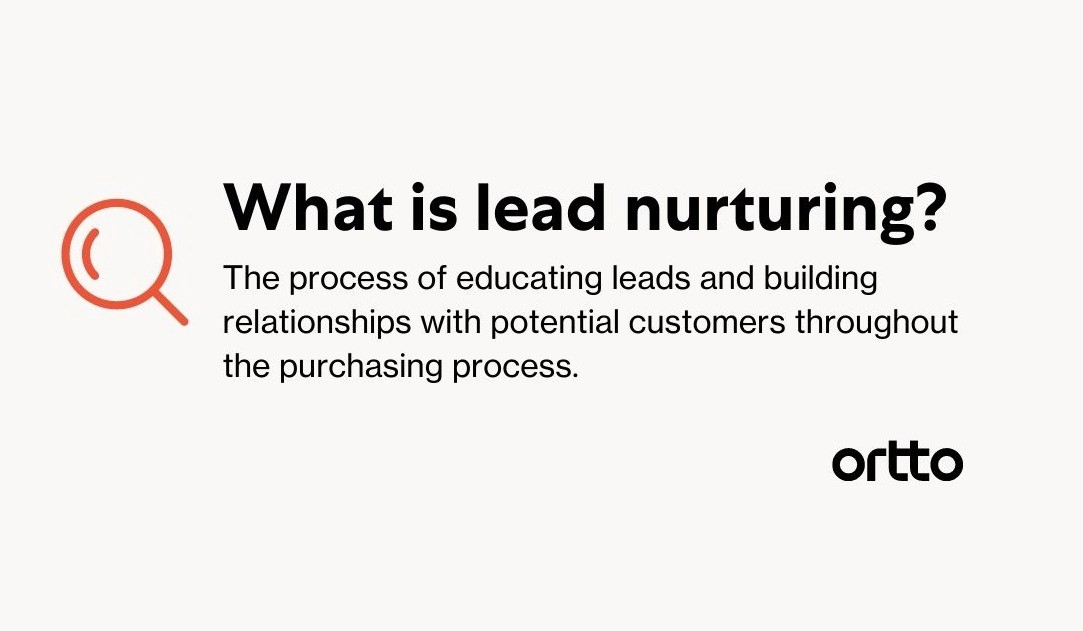
Lead nurturing process
From a technical standpoint, lead nurturing involves the automated delivery of communications — emails, onsite messages, text messages, and more. At Ortto, we call these strings of communications a “journey."
Journeys are able to be triggered from either user behavior or timing. They educate recipients with targeted content, while simultaneously building a customer profile so it’s clear when a lead is qualified and ready for sales.
The good news is, it’s remarkably easy to create this nurturing ‘machine’. If you want to implement a lead nurture program for your business, Ortto have you covered. Just follow these five steps:
Define your goals for nurture
Identify and segment your contacts
Define your content strategy
Gather, create, and repurpose irresistible content
Put it all into action
1. Define your goals for nurture
The most successful lead nurturing programs start with clear goals, and upfront pipeline and revenue targets. The goals you define will influence how you craft your nurture journeys and set about educating and qualifying leads.
Here are some common lead nurturing goals:
If you have a sales team, generating new revenue by qualifying more leads for sales
If you don’t have a sales team, generating new revenue by converting more new leads into customers
Generating reactivation revenue by nurturing stale leads from your database
Retaining more revenue by educating and staying in touch with new leads, recent buyers, and existing customers
Once your goals are set, make sure you have the necessary measures in place to report on results and performance. Start with identifying what you’d like to track and where these reports will live. Most reporting can be pulled within Ortto, from email reports to conversion metrics and they don’t require any upfront configuration.
You don’t need to have everything set up before building your lead nurturing journey. But it’s helpful to have everything in place before launching, so refer back to this throughout the process.
2. Identify and segment your contacts
The next step is identifying who to target in your nurture journey. A platform like Ortto is able to house all of your customer data from different touchpoints. This makes it remarkably easy to develop a set of rich target segments by combining the following contact data sources:
Demographic information: who are the people behind the email addresses? Demographic data includes information like company, industry, job title, and location, which are gathered from a range of sources including email lists, form submissions, and your CRM platform.
Behavioral data: what web, email, or in-product behavior have your contacts engaged in? Behavioral data incorporates email activity, webpage visits, in-app events, or billing-related actions.
CRM status (if applicable): how have your sales or success teams engaged these contacts? Segment contacts based on whether they’ve spoken with sales, what their lead status is, who the lead owner is, which territory they are in, or the campaigns they’ve interacted with.
Use a combination of these filters to define the groups you want to target with your lead nurturing journey. They should all be individuals who opted in and showed interest at some point, but need a nudge to continue their journey.
Here are some common segments we see companies target:
There is always the option of splitting your lead nurturing group into segments based on target personas or key industries to better align your messaging. If this works for your business, stick with two or three segments and create a separate nurture journey for each one.
Here are some additional segments we see companies target:
One-touch wonders: those who took an action that captured them into your database (such as downloading a white paper or attending an event you sponsored) but you never heard from again.
Non-sales-ready leads: leads that sales reviewed, but didn’t engage with and instead marked as “not sales ready”.
Cold leads: leads that have sat in your database for months without any activity — not even an email click or website visit.
Pre-signup leads: leads who’ve identified themselves by subscribing to your content, but have not yet signed up for an account or trial.
There is always the option of splitting your lead nurturing group into segments based on target personas or key industries to better align your messaging. If this works for your business, stick with two or three segments and create a separate nurture journey for each one.
Here are some additional segments:
Verticals: break out your key verticals by using industry filters to determine if someone is in manufacturing, financial services, media, eCommerce, consulting, etc.
Company size: SMBs have different challenges than enterprises. Use firmographic data to segment your contacts based on company size, number of employees, or even market size. If you don’t have this data available, a data enrichment program like Clearbit can help you complete it, and can be integrated with Ortto using our custom API key.
Job title: executives care about results, while individual contributors care about making their day-to-day easier. If you sell to both, try separating the two groups to tailor communications.
Department: if you have buyers in multiple departments, break these out. Marketing and sales may use the same software, but they do so in very different capacities. If you don’t have department-level information but do capture their job titles, try pulling leads into your smart segment based on keywords (e.g., title contains “marketing” or “sales”).
Geography: a company in France works differently than those in the U.S. Similarly, companies in Texas likely don’t need to be aware of California laws. If your business is distributed, it probably makes sense to create nurture journeys for each location.
It’s your job to ensure each contact gets the information they need to take the next step. Understanding your audience and their needs will make it easier to select appropriate content.
Once you’ve identified your target segments, it’s time to focus on what content will help your contacts progress in their buyer’s journey.
3. Define your content strategy
There are three main stages in the buying cycle, each with its own unique conversation happening in the lead’s mind. Early on, individuals are looking to do research about a general topic or pain point. From there, they move into evaluating potential solutions. Finally, they’re ready to make a purchase.
The trick is to match the type of content you’re sending to where leads are in the buyer’s journey. We call this the nurturing content funnel.
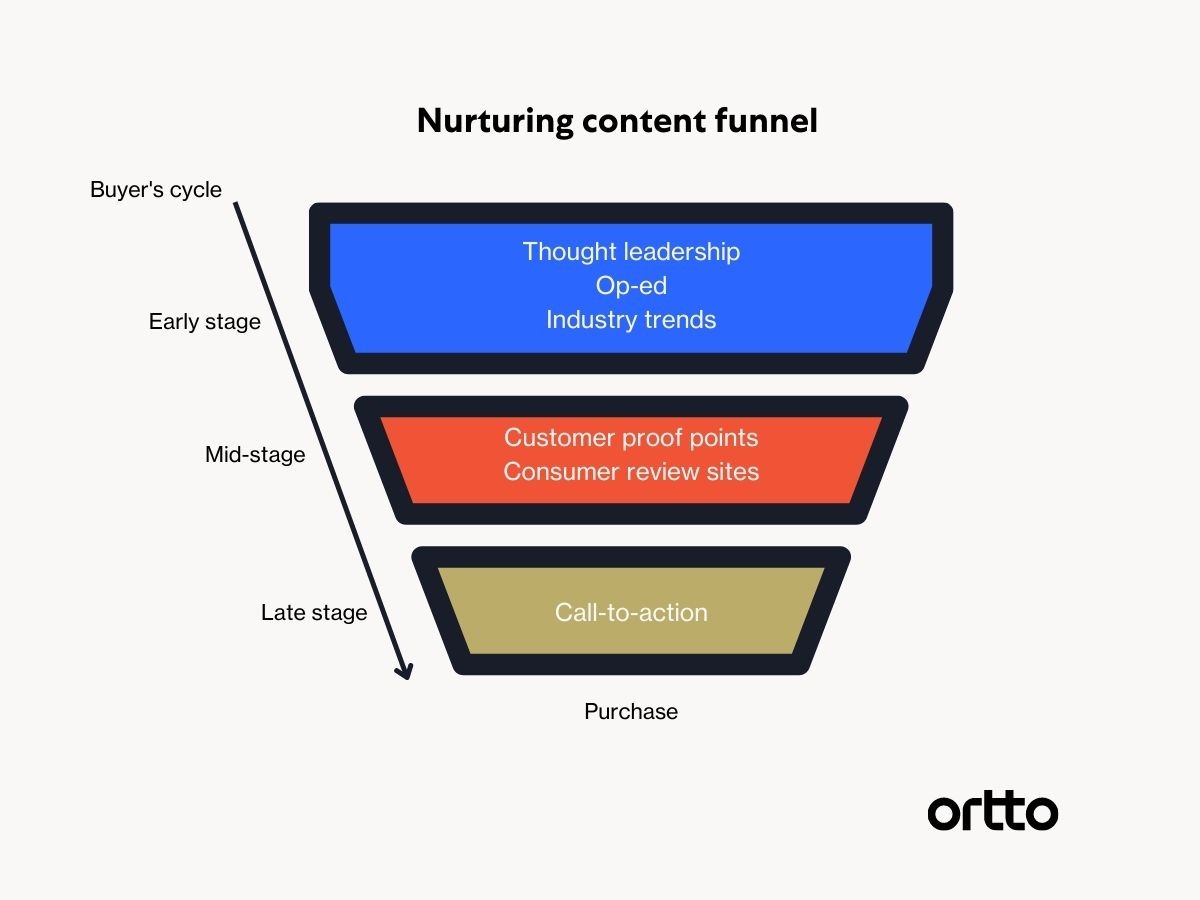
At the top of the funnel, contacts don’t know much about you. They’re new to your brand (and perhaps even your industry), which is why they’ve engaged so little. The most effective content here will build your company narrative by linking to industry trends, pain points, and shareable facts, all while positioning your brand as an industry leader.
In the middle of the funnel, contacts are further into their buying journey. They’ve identified an interest or pain point, but need to learn more about your company, product, or service. Send them customer proof points, tools that help them evaluate your solution, and company reviews.
At the bottom of the funnel, contacts are familiar with your brand and are ready to take action. It’s now time to send targeted call-to-action emails, such as invitations to set up a demo or sign up for a trial.
4. Gather, create, and repurpose irresistible content
The most important element of your lead nurturing journey is the content itself — what topics you address, what assets you include, and what emails you send. In this step, we’ll dig into how to do an audit of your existing content, what content works best, and how to design emails for your lead nurturing journey.
Do a content audit
People often get discouraged by their “lack of content”. Whether you have a large content library or one treasured ebook, chances are you have more content than you think.
What resources do you have at your disposal? Reach into your company’s archives and repurpose what you can. As long as it’s valuable, it’s okay if the content is a few months (or even years) old.
Here are a few places to extract content from:
Blog content is a great source for top-of-funnel content. Pull a list of all your published posts, then sort by popularity (shares or views) to call out posts you should highlight.
Your website contains a treasure trove of valuable content — filled with information about products, pricing, company background, and customer stories.
Review past announcements, newsletters, or promotional emails that you’ve sent to your customer list. Repurpose what you can to reignite stagnant leads.
Social channels are loaded with conversations prime for repurposing into lead nurturing emails or SMS. Pay special attention to tweets you can expand upon.
Once you’ve taken stock of your existing content, select the best pieces of content to captivate your audience and get them clicking!
Craft emails that solicit clicks
Based on the content you select for your nurture journey, create summary emails that hook your reader and link them to the source content.
Use a simple, one-column, on-brand HTML template for your lead nurturing emails. Reserve plain-text emails for more personalized communications, such as invitations to a custom demo or for feedback.
Keep it short and to the point. The goal here is to grab your reader’s attention and have a clear call to action. It’s about delivering value, which draws your contacts back for more.
Identify the assets that convert best
Content takes many shapes – from blog posts to videos, diagrams to infographics. Everyone absorbs content differently, so try to include a good mix of asset types. Plus, some messages are better communicated through specific mediums. Here, we’ve listed a few that are well suited for nurture.
White papers and eBooks are long-form pieces of high-level content. White papers are ideal for diving into more complex topics. Plus they can even be gated behind a form.
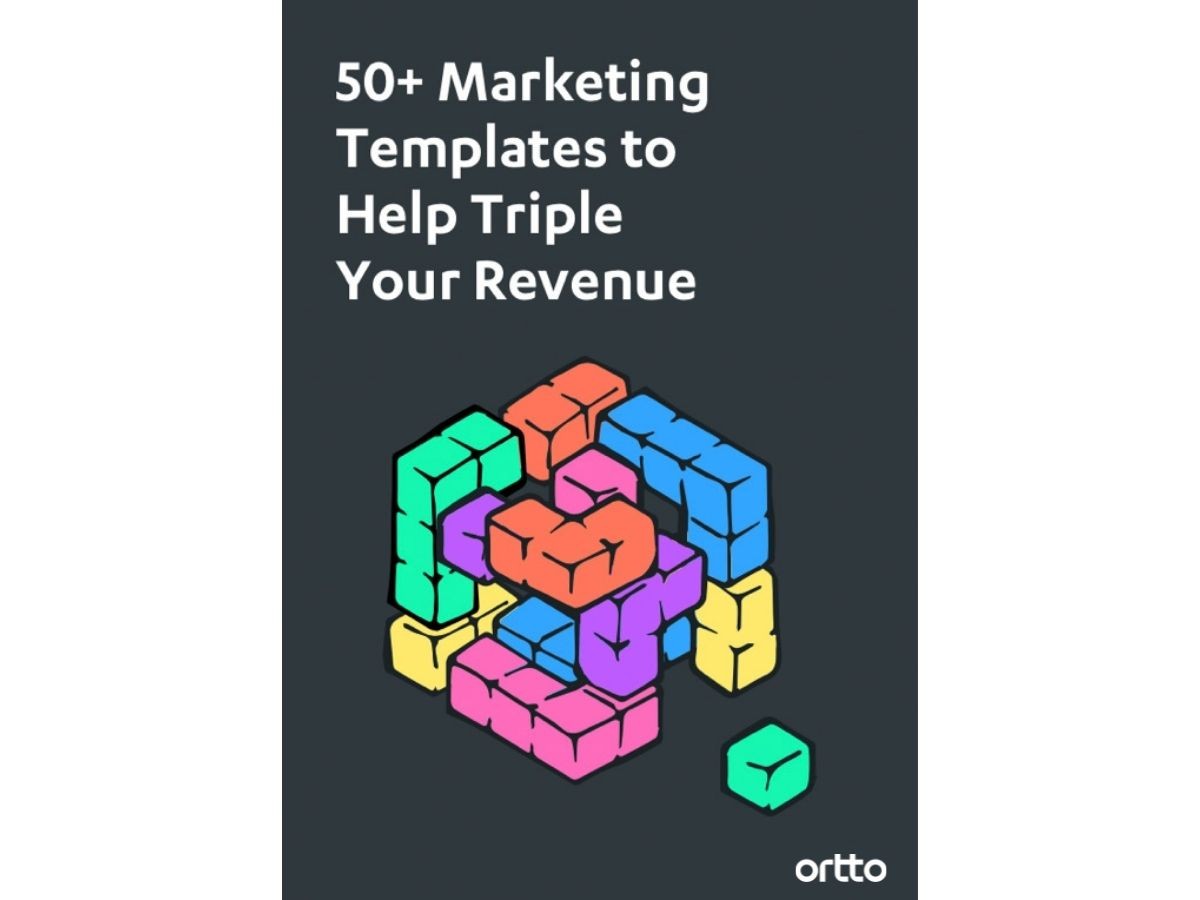
Thought leadership articles can be leveraged to convince folks who’re new to your space why they should care about your product or solution in the first place.
Webinars are an effective way to engage more directly with leads in a one-to-many format. You can present a range of content, from early-stage content all the way to late-stage content. Plus, prospects get their questions answered in real time.
Infographics provide an engaging and skimmable format for data-driven storytelling. Present compelling data points you’ve found or use your original research findings in an infographic.
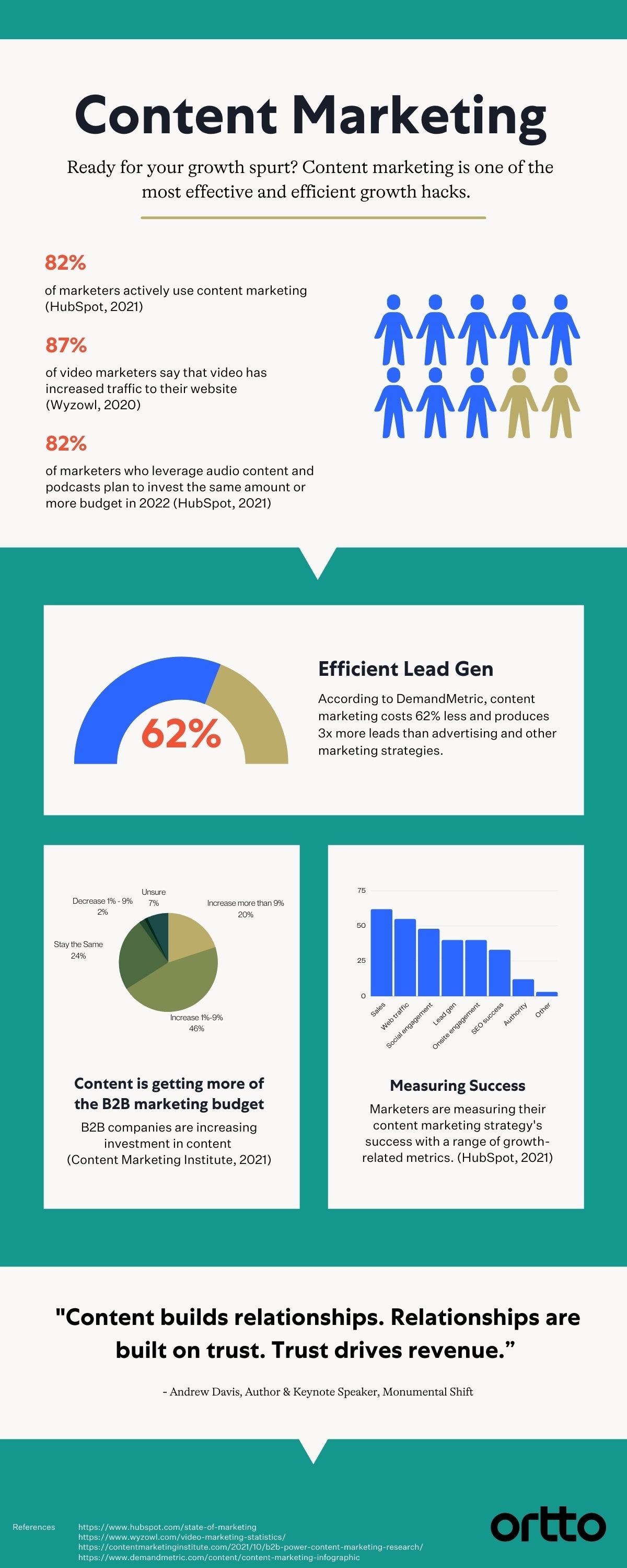
Newsletters enable you to deliver multiple updates at once. Try creating an industry newsletter with top-of-funnel content to engage prospects early on.
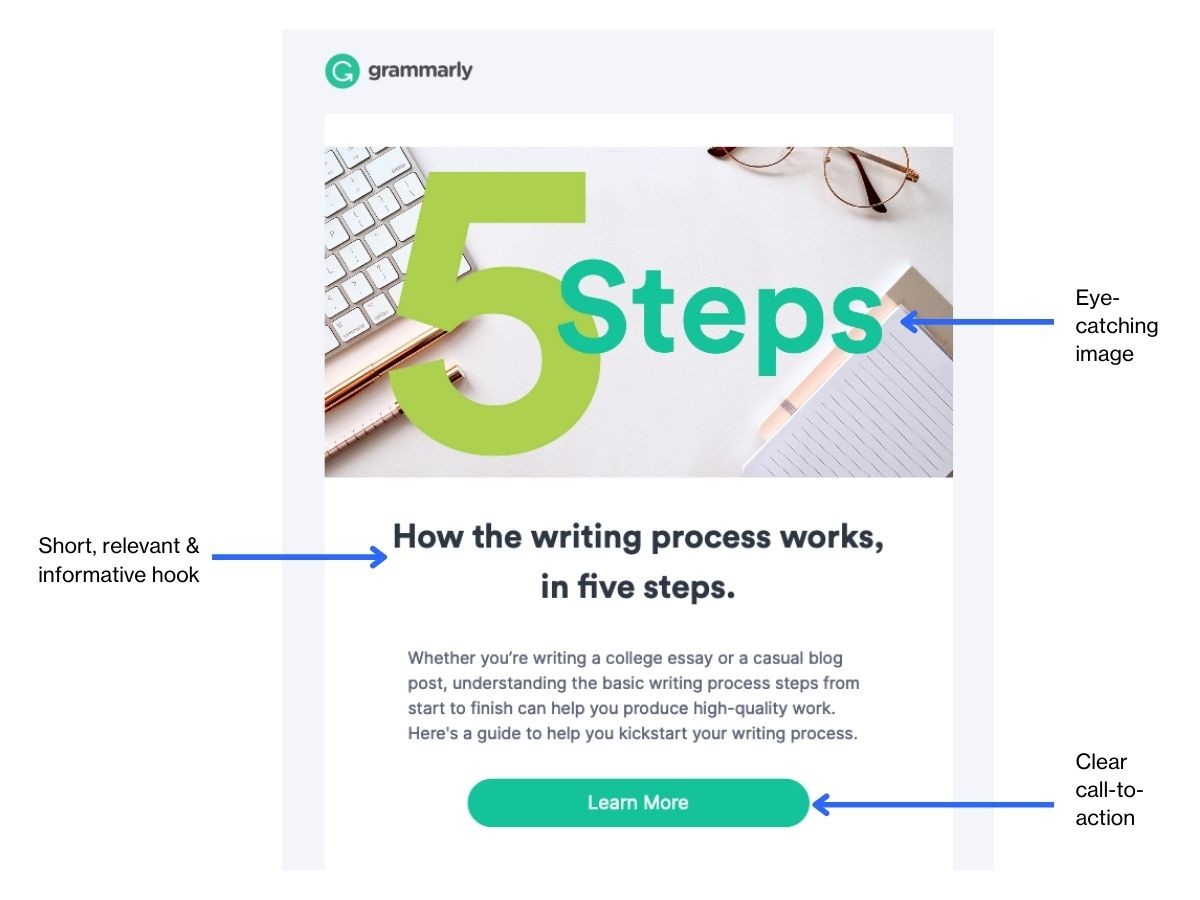
How-to videos are another great medium to experiment with. These videos are often cheaper to produce, show your product in action, and enable users to engage.
Customer testimonials are a form of validation. Prospects hear of the problems solved by your company and the results achieved straight from your customers’ mouths. Use customer testimonials to boost your credibility with social proof.
Free trial. While it doesn’t work for all products, offering a free trial is a great way for leads to try your product before committing to anything. Your customer is able to figure out what the value of the product is on their own.
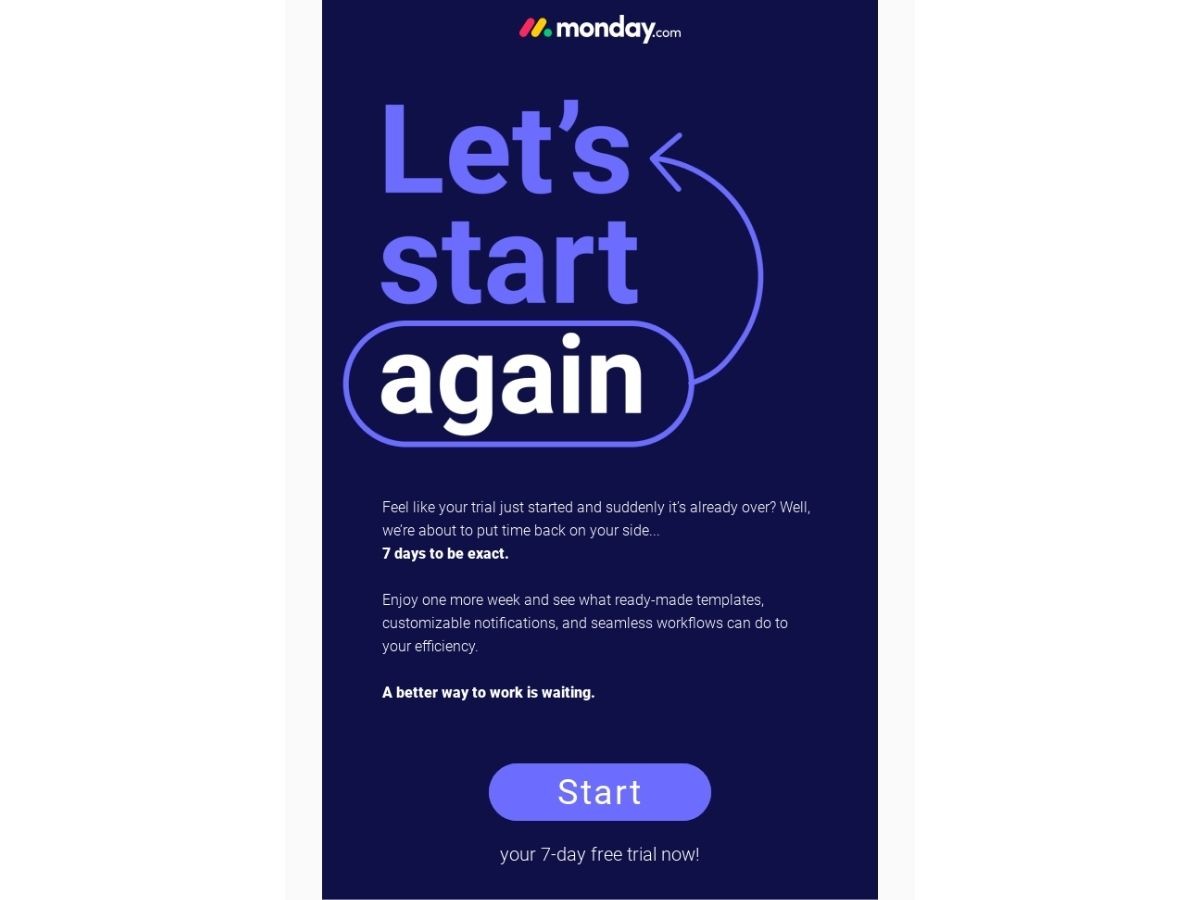
Some people prefer long-form white papers or ebooks, while others learn best from videos and webinars. Take these different preferences into consideration if you want your lead nurturing journey to capture your audience’s attention.
5. Put it all into action
Lead nurturing takes time to plan, launch, and improve, but once you launch your journeys, the impact on your business will immediately be visible. The most important thing to remember is that you’ll see a huge benefit from even the most basic nurture journey.
Launching a lead nurturing program will increase your brand awareness, engage and educate leads, stimulate conversions, and grow your bottom line. Companies that successfully nurture and reactivate stale leads grow faster while spending less on customer acquisition.
5 lead nurturing email examples
Imitation is the biggest form of flattery right? We have gathered 7 best-in-class examples from industry leaders, to help spark the creative side of your brain.
Sprout Social: the feature plug
As a Saas Company, feature launches are the perfect excuse to reach out to customers. Highlighting a feature release gives your audience a reason to look into your product in more detail — especially if it's solving a pain point. In Sprout Social's case, it's a fantastic way to get in touch with trialists and cold leads.

TheZebra: the reminder
Reminder emails can be tough to execute. The balance between timing, frequency, and content quality is tricky: you want to keep your customers in the loop without annoying them.
As far as content goes, TheZebra hits the nail on the head with this email — direct, to the point, and most of all, useful. A reminder is no good unless it's providing the recipient with value.
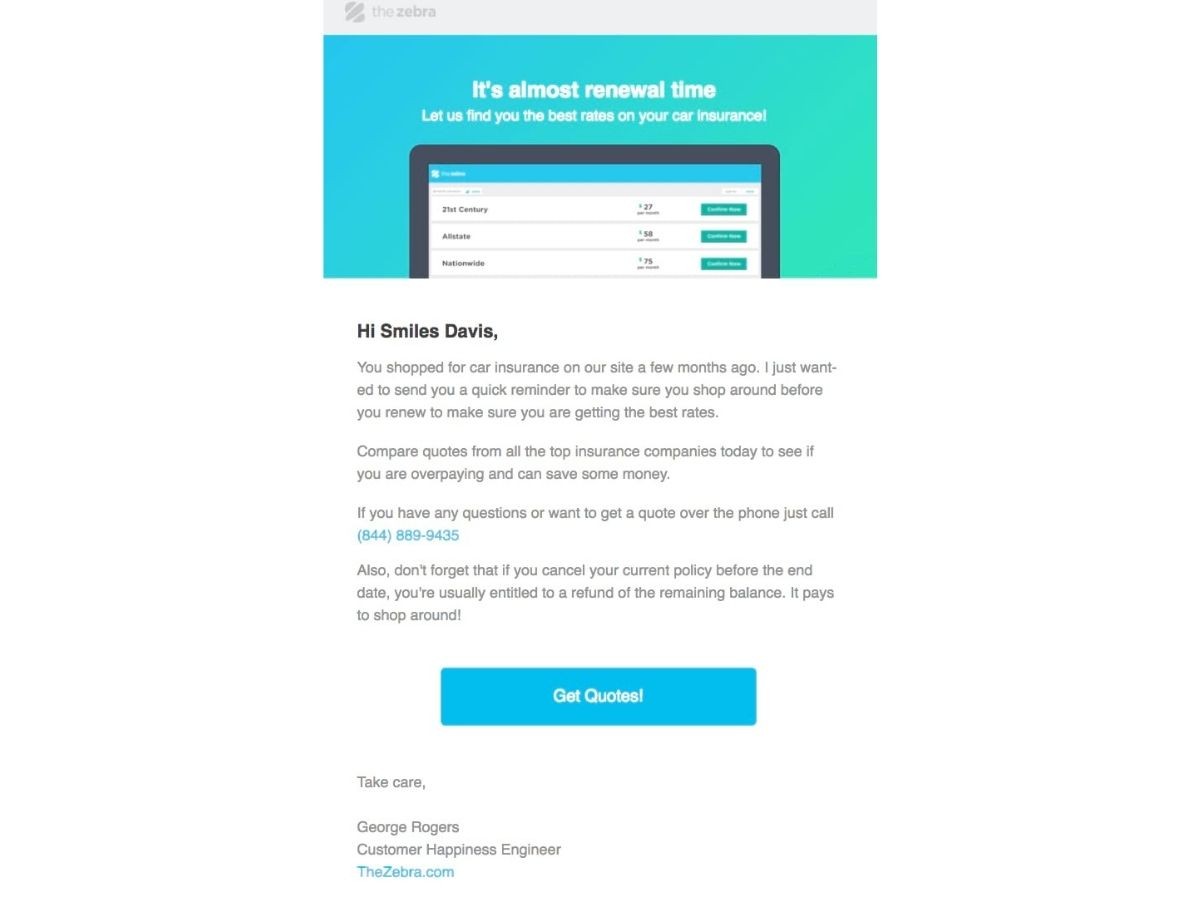
Typeform: the "I miss you"
In the SaaS world, sometimes users drop away and start churning. When this happens to Typeform, they handle it tactfully with an earnestly written email. They don't ask too much of their users here. Just a simple nudge towards the template gallery and a fun game.
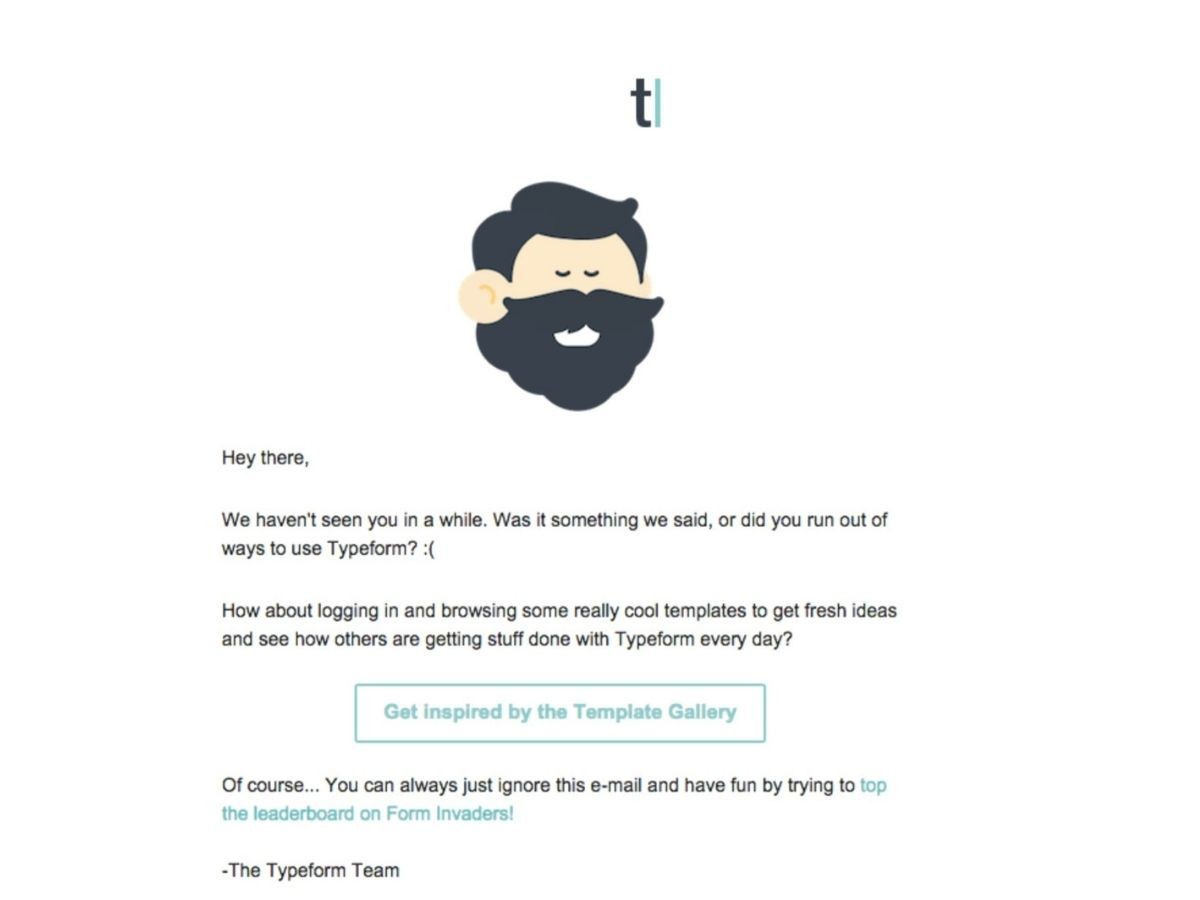
Casper: the light-touch approach
An elegant approach to the abandoned cart email, Casper doesn't distract you with anything but the essentials. Bold font choice, great design, and clever copy make this email striking to the eye without needing to rely on imagery. The review is a nice touch, too.
You can create abandoned cart emails like this one with the segment integration in Ortto.
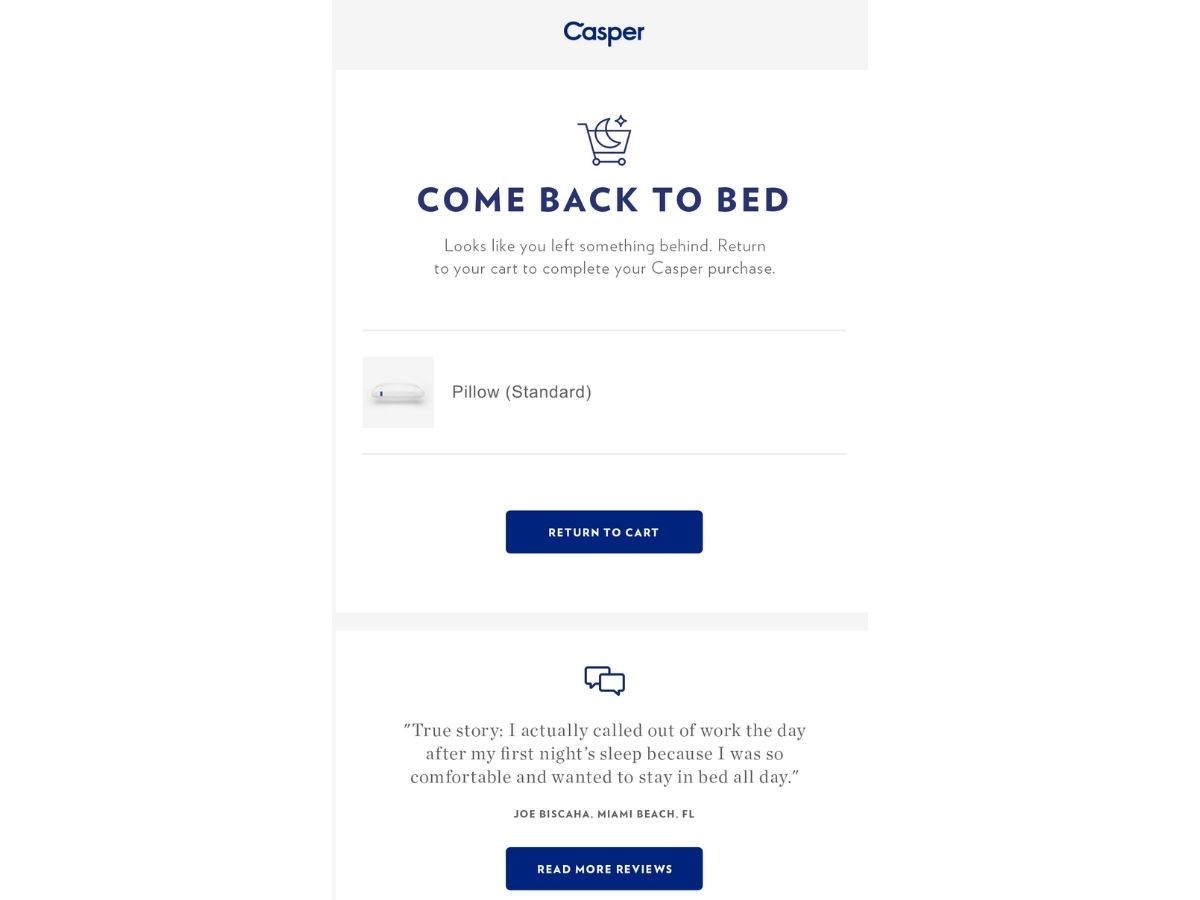
Duolingo: the contest
Duolingo reached out to students with a highly engaging and targeted email. This is a great way to engage an audience twofold: once with the original recipient, and a second time when teachers are nominated.
Note the two CTAs: each is focused on separate behaviors, without diluting one another. With a few testimonials sprinkled in for good measure, emails like this are sure to get people clicking.
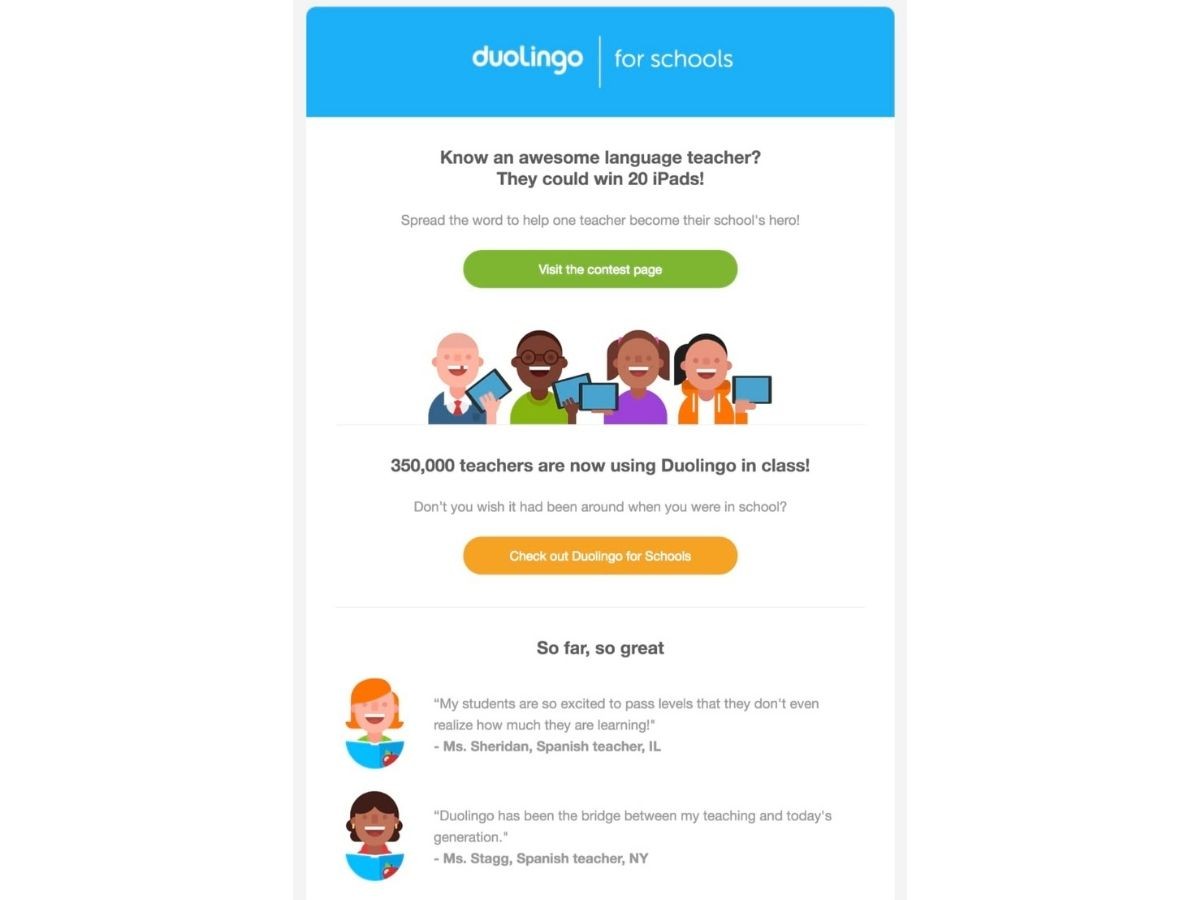
Your most common lead nurturing questions answered
Learning anything new, it's likely you have a ton of questions. We’ve collected a few frequently asked lead nurturing questions, that will hopefully fill in any information gaps, and help you on your way to being the next lead nurturing expert.
How do I start nurturing leads?
The first step in nurturing leads is understanding and defining your target customers. Start off by answering the following questions:
Who are your customers? - What are the basic demographics of your target customers? What are your customer personas?
What are their pain points? - Why are they seeking out your solution?
What words do they use to describe their pain points? - Hint: They probably don’t use the same industry jargon that’s often used in marketing.
How does your product solve their dilemma? - Focus on the benefits you offer but don’t just make a list of features.
Once you have a basic understanding of who your ideal customer is and what they need, now the fun part begins - create content speaking directly to prospective customers and highlighting your solutions to their problems.
Can I sell while nurturing leads?
Lead nurturing is a delicate balance of educating the prospect and pushing them towards buying. While it’s important to not come across like an intense salesperson, you also don’t have to ignore the pink elephant in the room. Both you and the prospect know the end goal is for conversion. It’s not a secret.
However, your main objective when nurturing leads isn’t to close the deal, it’s to provide the prospect with enough information and resources to build trust eventuating in apurchase. You’ll see the payoff in the long run.
What role does email play in lead nurturing?
Basically, no lead nurturing strategy would be complete without email marketing. The two work hand in hand. Together, they allow you to reach your prospects on a consistent basis.
When a prospect visits your landing page and subscribes to your emails, they’ve actually given you permission to market to them directly. You don’t have to cross your fingers and hope they remember to return to your website.
Now with their details, you are able to send through relevant, meaningful content, to prove to them why purchasing your product or subscribing to your service will be their best option.
And because you’re a smart and patient brand, you won’t just constantly bombard your subscribers with hard sales.
Final word
Buyers typically spend months researching and evaluating solutions before deciding on a vendor. Delivering useful and relevant content to buyers via an automated nurture journey accelerates this journey while driving higher conversion rates and improving your sales efficiency.
Author

More by Sidney O'Connell
Sidney O'Connell has no more articles


